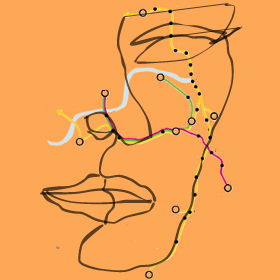By Marisse Cato
A brightly illuminated studio presents the inner world of artist Tracey Elizabeth Downing. Gleaned from her subconscious and presented in a flattened composition of objects, her art has a shifting vibrancy, as though the image could change if you look away.
With no interest in painting things as they are, her work centres on ritual and ephemerality, exploring memory through objects. This description however sums up a process that’s much more than meets the eye. Tracey explains “there’s a lot of thinking before [painting] and a lot after. Often quite after I’ve made a work is when I realise what it’s about. In that way the work is about memory…It’s not conscious, a lot of my work isn’t conscious.”

Tracey’s studio, whilst covered in works in progress and some finished pieces, also has a wall of various objects, often related to the motifs found in the artist’s work. Teacups, clouds, lips, lemons, stages, bathtubs, bodies of water, windows, houses, pink curtains…all motifs that keep popping up supported by a collection of objects acquired along the way, important to her, through memory and experience.
TED: “Wherever I am, random things like smells, buildings, textures, fabrics will just take me back to memories from a really long time ago. I’m really interested in if there are other people who have this thing, that they are drawn back to memories on a regular basis. Sometimes it can feel like a bit of an affliction. But putting a positive spin on it, it’s a kind of readdressing of times that were probably quite difficult in my life. It’s probably like a radical acceptance. You can’t control your thought life; you just have to deal with them as they come.”
Interested in this process of the triggering of memories, and how these experiences find their way into the work, Downing’s work is much more about her interior world as these objects turn into symbols and take on meaning in their relationality.
A key recurring symbol and object across her work is lemons. A longstanding feature of Classical European art in still-life, it was the experience of smelling a lemon soap that functioned as a Tardis to somewhere in Tracey’s memory that she couldn’t quite pinpoint. Still unsure of the sensory memory’s particular reference point, Tracey showed me a ceramic lemon on her wall of objects. In amongst the myriad of lemon associated sayings and proverbs, they have come to function as a key symbol in Tracey’s work. “I love that it’s not a lemon because it’s ceramic. And they are kind of a bit nipple-y…thoughts of sour milk…it all
ties into my experience of being mothered…as opposed to mothering.”


Whilst she isn’t aiming for a particular aesthetic, a clear set of colour compositions seem to prevail – deep blue backgrounds, paler blue and white washes, red and pink pastels, all layered to create a translucent quality on objects that seem to float in a negative, magnetic space. Mindful of the potentially unhelpful pervasiveness of the notion of intuition in art, she nonetheless finds herself pulled back to the same colours and styles, even when she does
try to switch things up.
Alongside her painting work, Tracey also writes what she calls “Moems”, momentary thoughts captured or on a bad day, a poem moan hybrid. Describing her painting and poetry work as sort of “leapfrogging over eachother”, the balance between visual art and the written word comes into question. Does art require explanation? Does a literary component contribute to or over-explain what’s on the canvas? How should art-appreciators interpret them when presented together?
During the TURPS Correspondence Course where artists are matched with a mentor whose feedback they receive only through letters with no in person meeting, Tracey recounts receiving the following feedback; “the textured underpainting…for me becomes slightly turgid and overwhelming…It seems supposed to guarantee ‘meaningfulness’ and yes that meaningfulness relies on something unseen and unavailable to me. I can guess, but my guess is less compelling than what I actually want to see, which is what is actually there and
needs to stand and hold up on its own.” Whilst perhaps a particularly curt take, Tracey remembers really appreciating this honest feedback in helping her consider more carefully her (un)/conscious processes. Intentionally working to use less imagery and less paint, considering themes of absence she said the following:


TED: “Ironically, a lot of work artists make toward the end of their career, the more simple the work becomes. It’s almost like Benjamin Button…going forwards is like going backwards stylistically. I’m not going to worry if my work looks like a 6-year-old did it, because maybe it is a six-year-old doing it it…maybe it’s my six-year-old…who knows.”
You can see more of Tracey’s work at her website www.traceyelizabethdowning.com with access to a monthly newsletter including a moem! See her work in progress and which artists she is engaging with on her Instagram @traceyelizabethdowning.

Leave a Reply